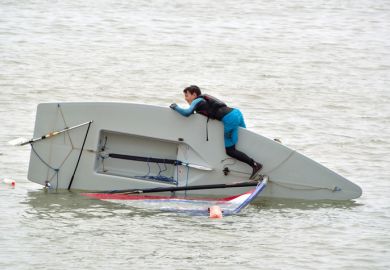The increasing importance of interdisciplinarity in the UK’s research excellence framework went largely unmentioned amid the disappointment over the failure of the funding bodies’ document Initial decisions on REF 2021, published last month, to resolve issues over portability of outputs and numbers of submissions.
But it should not be overlooked. In 2021, interdisciplinary research will be assessed “as a discrete section” of the research environment, and every assessment subpanel will include a member whose remit will be to review interdisciplinary submissions. This is welcome: small gains in emerging areas can contribute to more robust REF scores. The difficulty, of course, is knowing exactly how interdisciplinarity might be defined and valued.
As chair of the British Society for Literature and Science, I have often been called on to define aspects of interdisciplinary research. For years, I thought I knew what it was. The more I spoke with others in different disciplines, however, the less sure I became. And when, about a decade ago, “impact” emerged as a word of magical power at the research councils, “interdisciplinarity” (it really needs an exclamation mark in this context) became bewilderingly wide ranging and diffuse. One might even resort to the same definition that US Supreme Court Justice Potter Stewart famously gave pornography in 1964: “…perhaps I could never succeed in intelligibly [categorising it]…but I know it when I see it.”
This is not going to suffice for the REF, of course. Nor is it going to be possible for a single “interdisciplinary tsar” to assess every example of interdisciplinary research: that would require the kind of polymathic ability that ended with the Victorians. Assessment will, then, devolve to the criteria that subpanels put in place. This is nothing new. Subpanellists are already asked to work outside their own specialisms, and do so conscientiously, in the knowledge that there are always two readers, and that anomalies will be spotted and addressed.
It seems likely that this double-review system will stay in place for interdisciplinary work as well, and that it will be the assessment criteria that ultimately matter. So what might those criteria be? Several relevant reports have come out in recent years in the UK, most notably the Case Study Review of Interdisciplinary Research in English Higher Education Institutions, published last year by the Higher Education Funding Council for England.
Based on such reports, I suggest four assessment criteria that might be adopted in the REF. First, how diverse are the disciplines (or organisations) in collaboration, and how suitable are the combinations? Elsevier’s report analysing the interdisciplinary research publications submitted to REF 2014 also recommended that assessors look carefully at how conceptually and physically “far away” from one another disciplines in collaboration were. So if we collaborate well with very different and geographically distant disciplines and industries, we could be viewed favourably.
Next, how have we mixed our methodologies? Clarity of methodological approach and lucid articulation of its purpose is regarded as vital to understanding how interdisciplinarity gives added value and increased rigour to research. Hefce’s report is not the only one to stress the importance, in that context, of clear language and framing of both method and the understanding that it engenders.
Another criterion might consider the cognitive and social skills that have to be learned for interdisciplinary knowledge to flourish: the new vocabularies, networks and ways-of-being that are different in each discipline.
Finally, how adventurous is the research? Interdisciplinarity still basks in the glamour of risk-taking and innovation. Publications should aim to capture what the Hefce report refers to, somewhat obliquely, as the unique “in-between-ness” of interdisciplinary knowledge: the hard-to-capture knowledge that emerges in the space between interacting disciplines. Making an effort, therefore, to articulate the benefits of risk and the gains achieved through innovation might undergird successful results.
So, in short, if you want the best interdisciplinary scores, use international partners, preferably in Australia, and definitely in industry. Mix your methodologies. Write extensively about mixing your methodologies. Don’t forget the bravery of boundary-breaking. Support the research through a centre of collaborative excellence. Name everyone on the paper. Submit. And relax.
Martin Willis is professor of English at Cardiff University, chair of the British Society for Literature and Science and editor of the Journal of Literature and Science.
POSTSCRIPT:
Print headline: Get maximum marks for novelty
Register to continue
Why register?
- Registration is free and only takes a moment
- Once registered, you can read 3 articles a month
- Sign up for our newsletter
Subscribe
Or subscribe for unlimited access to:
- Unlimited access to news, views, insights & reviews
- Digital editions
- Digital access to THE’s university and college rankings analysis
Already registered or a current subscriber?








